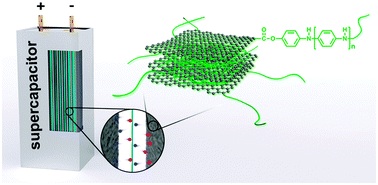Electrochemical supercapacitors from conducting polyaniline–graphene platforms
Abstract
Energy storage devices such as electrochemical supercapacitors, with high power and energy densities are required to address the colossal energy requirements against the backdrop of global warming and the looming energy crisis. Nanocarbon, particularly two-dimensional graphene and graphene-based conducting polymer composites are promising electrode materials for such energy storage devices. Owing to their environmental stability, the low cost of polymers with high electroactivity and pseudocapacitance, such composite hybrids are expected to have wide implications in next generation clean and efficient energy systems. In this feature article, an overview of current research and important advances over the past four years on the development of conducting polyaniline (PANI)–graphene based composite electrodes for electrochemical supercapacitors are highlighted. Particular emphasis is made on the design, fabrication and assembly of nanostructured electrode architectures comprising PANI and graphene along with metal oxides/hydroxides and carbon nanotubes. Comments on the challenges and perspectives towards rational design and synthesis of graphene-based conducting polymer composites for energy storage are discussed.


 Please wait while we load your content...
Please wait while we load your content...